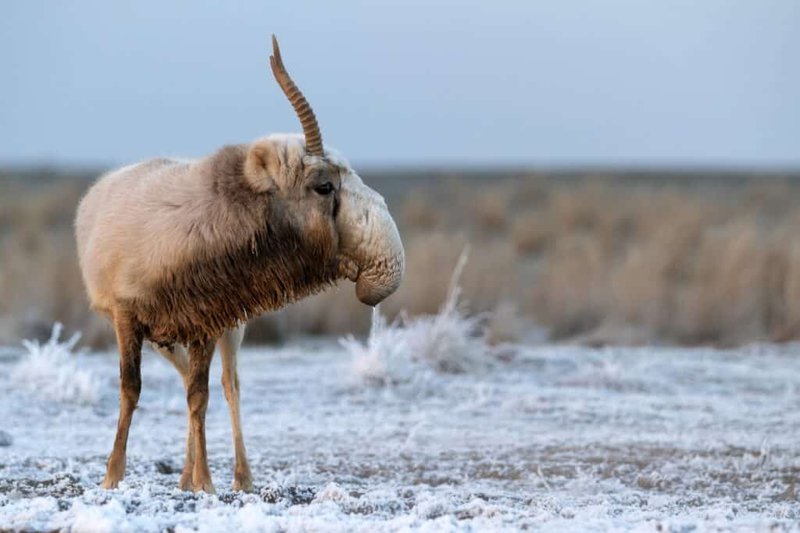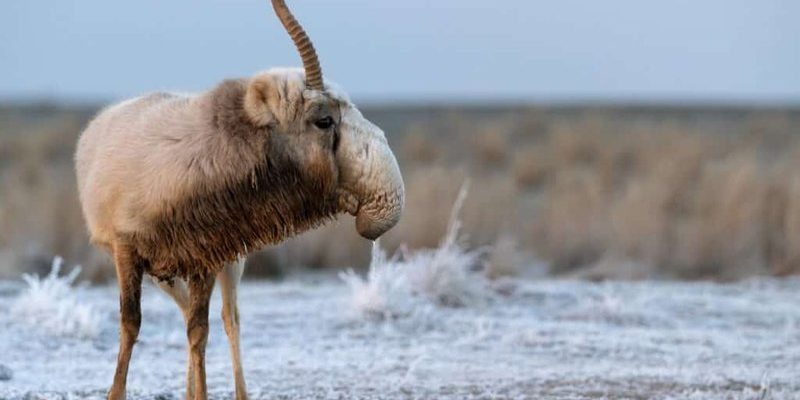
Understanding how saiga antelopes manage to survive in such challenging environments is fascinating and, quite frankly, a testament to the wonders of evolution. Their unique adaptations allow them to not only endure but thrive amid the unpredictability of nature. Let’s take a closer look at what makes these creatures so remarkable, from their physical traits to their survival strategies.
Physical Adaptations to Extreme Weather
One of the most striking features of the saiga antelope is its oversized, floppy nose. You might be wondering why that’s important. Well, here’s the thing: that nose isn’t just for show. It plays a crucial role in how these antelopes deal with the extreme temperature changes in their habitat. During the scorching summer months, the saiga’s nose helps to cool the air before it enters their lungs, much like how a car air conditioner works. On the flip side, during the freezing winters, the nose also warms the cold air, making it more manageable.
Additionally, saiga antelopes have thick coats that allow them to withstand harsh winters. Their fur changes with the seasons; it’s dense and warm in winter, providing insulation against chilly winds. In summer, they shed this heavy coat, trading it for a lighter, more breathable layer to keep cool. It’s amazing to see how these animals change their fur to adapt to the seasons, kind of like how we swap our winter jackets for lighter clothes when spring arrives.
Mobility and Grazing Habits
Saiga antelopes are also built for endurance. They have long legs that allow them to cover vast distances in search of food and water. This is essential in their dry, expansive habitats where resources can be sparse. They are grazers and primarily feed on grasses, herbs, and shrubs—vegetation that often requires roaming long distances to find.
You might think that wandering around all day sounds exhausting, but the saiga is well-equipped. Their hooves are specially adapted to their environment, allowing them to run swiftly over dry, uneven terrain while escaping from predators. This mobility not only helps them find food but also plays a key role in their survival strategy.
Social Structures and Behavior
Saiga antelopes are social animals that thrive in groups, which is another smart survival tactic. By living in herds, they can better protect themselves from predators like wolves and leopards. There’s safety in numbers, after all! When a potential threat approaches, the herd can communicate and move together, making it harder for a predator to single out an individual.
The social structure of saiga herds is fascinating, too. During the breeding season, males compete for females, showcasing their strength and fitness. This creates a natural selection process, ensuring that only the healthiest genes are passed down. It’s like a natural way of ensuring the survival of the fittest!
Reproductive Strategies
Speaking of breeding, saiga antelopes have developed unique reproductive strategies to ensure the survival of their young. They typically give birth in late spring, coinciding with the arrival of fresh grasses. This timing helps provide the newborns with ample nutrition in their early weeks, which is critical for their development and overall health.
Mother saigas can often be seen caring for their young in secluded areas, providing a safe environment for the calves to grow. Interestingly, calves are able to stand and run alongside their mothers shortly after birth, which is essential for keeping up with the herd and avoiding predators.
Water Conservation Techniques
Living in the arid landscapes of Central Asia means that water can be hard to come by, especially during hot periods. Saiga antelopes have developed some impressive methods for conserving water. For example, they can tolerate a degree of dehydration that would be fatal for many other mammals. When water is available, they will drink large quantities to stock up, which helps them survive during those dry spells.
Additionally, these antelopes have learned to feed on moisture-rich plants, which helps them stay hydrated without needing to drink as much water directly. It’s their way of innovating and finding solutions in an environment that’s not always forgiving.
Adapting to Human Impact
Unfortunately, saiga antelopes face challenges beyond just natural conditions. Human activities, such as habitat destruction and poaching, have put significant pressure on their populations. However, conservation efforts are underway to help protect these unique animals. Educating local communities about their importance and creating protected areas can make a big difference.
Moreover, understanding how saiga antelopes survive in harsh environments can inspire broader conservation strategies. It’s a reminder that every creature plays a role in the ecosystem, and protecting their habitat is crucial for their survival—something we should all care about.
The Role of Saiga Antelopes in Their Ecosystem
Saiga antelopes aren’t just resilient; they also play a vital role in their ecosystem. By grazing on grasses and other vegetation, they help maintain the health of the landscape. This grazing prevents overgrowth and encourages a diverse plant community, which benefits various other animals as well.
When saiga move through their habitats, they also help disperse seeds, promoting plant growth. This ecological role means that their survival is important not just for them but for the entire ecosystem in which they live. It’s a delicate balance, and losing such a unique species could have far-reaching consequences.
Conservation Efforts and Future Outlook
As we learn more about how saiga antelopes survive in harsh environments, it’s essential to support conservation efforts aimed at protecting them. Organizations are working to mitigate the impact of hunting and habitat loss, creating viable populations for the future.
You might be wondering how you can help. Raising awareness about saiga antelope conservation, supporting wildlife organizations, and even just spreading the word about their incredible adaptations can contribute to their survival. Every small action counts!
Saiga antelopes are a stunning example of adaptation and resilience in the face of harsh environmental challenges. From their unique physical traits to their social structures and reproductive strategies, these animals have found ways to thrive where many would struggle. As we continue to explore and understand their world, let’s remember that their survival isn’t just about them; it’s about the health and balance of our entire ecosystem.
Understanding how saiga antelopes survive in harsh environments reminds us of the beauty and complexity of life on our planet. If we can work together to protect these incredible animals, we’re not just preserving a species; we’re safeguarding the rich tapestry of life that connects us all.

